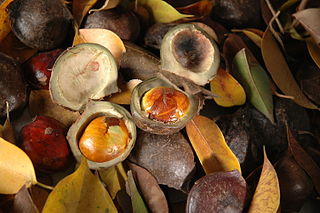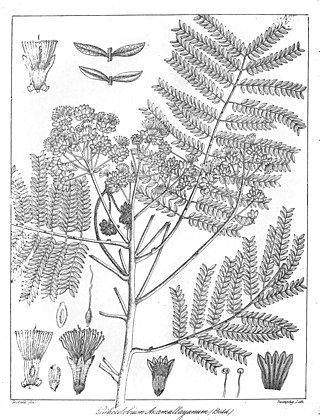
Albizia is a genus of more than 160 species of mostly fast-growing subtropical and tropical trees and shrubs in the subfamily Mimosoideae of the family Fabaceae. The genus is pantropical, occurring in Asia, Africa, Madagascar, America and Australia, but mostly in the Old World tropics. In some locations, some species are considered weeds.

Abarema is a neotropical genus in the family Fabaceae. It is native to Brazil, Cuba, and Venezuela. Most of the species can be found in the Amazon Basin and the Guyana Highlands. They have a deep-green fernlike foliage, with bipinnately compound leaves.

Kaeng Krachan National Park is the largest national park of Thailand. It is on the border with Burma, contiguous with the Tanintharyi Nature Reserve. It is a popular park owing to its proximity to the tourist town of Hua Hin. It was named a UNESCO World Heritage Site on 26 July 2021, despite concerns from the OHCHR around the human rights violations of the indigenous people that live in the park.
Archidendron forbesii is a species of legume in the family Fabaceae. It is found only in Papua New Guinea. It is threatened by habitat loss.

Archidendron is a genus of flowering plants in the pea family, Fabaceae. It includes 98 species which range from India through Indochina, southern China, Taiwan, Malesia, and Papuasia to Queensland and New South Wales.
Archidendron oblongum is a species of legume in the family Fabaceae. It is found only in Solomon Islands.
Archidendron pahangense is a species of legume in the family Fabaceae. It is a tree endemic to Peninsular Malaysia. It is threatened by habitat loss.

Pithecellobium is a genus of flowering plants in the family Fabaceae. It includes approximately 23 species from the tropical Americas, ranging from Mexico to Peru and northern Brazil, including the Caribbean Islands and Florida.

Archidendron bigeminum is a tree species in the legume family (Fabaceae). It is found in India and Sri Lanka. It is known as "kalitiya - කලටිය" in Sinhala.

Archidendron pauciflorum, commonly known as djenkol, jengkol or jering is a species of flowering tree in the pea family, Fabaceae. It is native to Southeast Asia, where the seeds are a popular dish. They are mainly consumed in Indonesia, Thailand, Myanmar, and Vietnam and prepared by frying, boiling, or roasting and are also eaten raw. The beans are mildly toxic due to the presence of djenkolic acid, an amino acid which causes djenkolism. The beans and leaves of the djenkol tree are traditionally used for medicinal purposes such as purifying the blood. To date, djenkol is traded on local markets only.

Djenkolic acid is a sulfur-containing non-protein amino acid naturally found in the djenkol beans of the Southeast Asian plant Archidendron jiringa. Its chemical structure is similar to cystine but contains a methylene unit in between the two sulfur atoms. There is about 20 grams of djenkolic acid per kilogram of dry djenkol beans, and it has also been reported in smaller amounts in the seeds of other leguminous plants such as Leucaena esculenta and Pithecolobium ondulatum.

Archidendron grandiflorum, the pink laceflower, is a species of tree found in northern Australia and New Guinea. This tree reaches a height of 15 meters and bears showy pink and cream colored flowers. The mature tree has a rounded habit and is used as an ornamental. This tree is also called the lace flower tree, paintbrush tree, tassel tree, and tulip siris.
Archidendron microcarpum is a plant, native to the wild forests of Sumatra. It produces fruit, oval in shape and green with darker skin. The plant is notably potent. Typically, these plants live in the tropics, and includes plants that grow wild in the forests of Sumatra. This fruit smells like jering and banana. The trait makes kabau similar to them and thus it is consumed like both of the plants.
Cameraria borneensis is a moth of the family Gracillariidae. It is known from Sabah, Malaysia.

Archidendron hendersonii, the white lace flower or tulip siris, is a rainforest tree in eastern Australia. A rare plant, listed as vulnerable, it is named after J.A. Henderson, who collected the original specimen at Ballina.

Archidendron lucyi is a small tree species in the legume family (Fabaceae). The native range extends from North Eastern Australia, Eastern Malesia to the Solomon Islands. A. lucyi grows in the understorey of lowland rainforest.

Archidendron clypearia subsp. subcoriaceum is a subspecies of an Archidendron clypearia in the legume family (Fabaceae). It is found in India and Sri Lanka.

Archidendron vaillantii, commonly known as the salmon bean, is an evergreen tree in the legume family Fabaceae. It is endemic to the rainforests of northeast Queensland.













